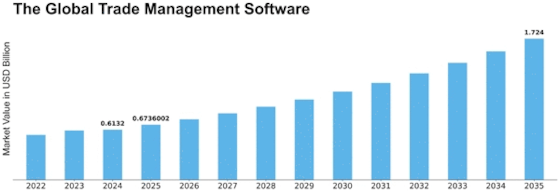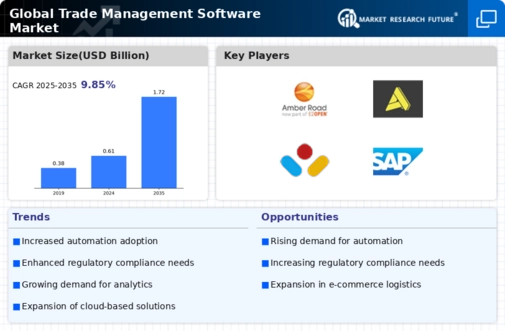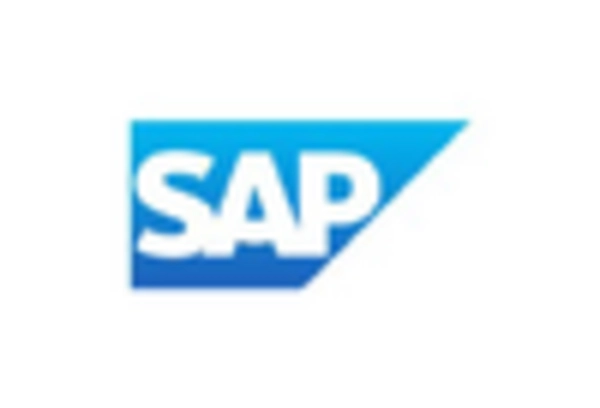Vendor Management
Invoice management
Trade Function
Import and Export Management
Implementing
Consulting
Cloud
On-Premise
Large enterprise
Medium enterprise
Defence
Pharmaceutical
Transportation
Logistics Consumer Goods Energy
North America Trade Management Software by SolutionVendor Management
Invoice management
Trade Function
Import and Export Management
North America Trade Management Software by ServiceImplementing
Consulting
North America Trade Management Software by DeploymentCloud
On-Premise
North America Trade Management Software by End UserLarge enterprise
Medium enterprise
North America Trade Management Software by VerticalDefence
Pharmaceutical
Transportation
Logistics Consumer Goods Energy
US Trade Management Software by SolutionVendor Management
Invoice management
Trade Function
Import and Export Management
US Trade Management Software by ServiceImplementing
Consulting
US Trade Management Software by DeploymentCloud
On-Premise
US Trade Management Software by End UserLarge enterprise
Medium enterprise
US Trade Management Software by VerticalDefence
Pharmaceutical
Transportation
Logistics Consumer Goods Energy
CANADA Trade Management Software by SolutionVendor Management
Invoice management
Trade Function
Import and Export Management
CANADA Trade Management Software by ServiceImplementing
Consulting
CANADA Trade Management Software by DeploymentCloud
On-Premise
CANADA Trade Management Software by End UserLarge enterprise
Medium enterprise
CANADA Trade Management Software by VerticalDefence
Pharmaceutical
Transportation
Logistics Consumer Goods Energy
Europe Trade Management Software by SolutionVendor Management
Invoice management
Trade Function
Import and Export Management
Europe Trade Management Software by ServiceImplementing
Consulting
Europe Trade Management Software by DeploymentCloud
On-Premise
Europe Trade Management Software by End UserLarge enterprise
Medium enterprise
Europe Trade Management Software by VerticalDefence
Pharmaceutical
Transportation
Logistics Consumer Goods Energy
Germany Outlook (USD Billion, 2019-2030)
Germany Trade Management Software by SolutionVendor Management
Invoice management
Trade Function
Import and Export Management
Germany Trade Management Software by ServiceImplementing
Consulting
Germany Trade Management Software by DeploymentCloud
On-Premise
Germany Trade Management Software by End UserLarge enterprise
Medium enterprise
Germany Trade Management Software by VerticalDefence
Pharmaceutical
Transportation
Logistics Consumer Goods Energy
France Trade Management Software by SolutionVendor Management
Invoice management
Trade Function
Import and Export Management
France Trade Management Software by ServiceImplementing
Consulting
France Trade Management Software by DeploymentCloud
On-Premise
France Trade Management Software by End UserLarge enterprise
Medium enterprise
France Trade Management Software by VerticalDefence
Pharmaceutical
Transportation
Logistics Consumer Goods Energy
UK Trade Management Software by SolutionVendor Management
Invoice management
Trade Function
Import and Export Management
UK Trade Management Software by ServiceImplementing
Consulting
UK Trade Management Software by DeploymentCloud
On-Premise
UK Trade Management Software by End UserLarge enterprise
Medium enterprise
UK Trade Management Software by VerticalDefence
Pharmaceutical
Transportation
Logistics Consumer Goods Energy
ITALY Trade Management Software by SolutionVendor Management
Invoice management
Trade Function
Import and Export Management
ITALY Trade Management Software by ServiceImplementing
Consulting
ITALY Trade Management Software by DeploymentCloud
On-Premise
ITALY Trade Management Software by End UserLarge enterprise
Medium enterprise
ITALY Trade Management Software by VerticalDefence
Pharmaceutical
Transportation
Logistics Consumer Goods Energy
Spain Trade Management Software by SolutionVendor Management
Invoice management
Trade Function
Import and Export Management
Spain Trade Management Software by ServiceImplementing
Consulting
Spain Trade Management Software by DeploymentCloud
On-Premise
Spain Trade Management Software by End UserLarge enterprise
Medium enterprise
Spain Trade Management Software by VerticalDefence
Pharmaceutical
Transportation
Logistics Consumer Goods Energy
Rest Of Europe Trade Management Software by SolutionVendor Management
Invoice management
Trade Function
Import and Export Management
REST OF EUROPE Trade Management Software by ServiceImplementing
Consulting
REST OF EUROPE Trade Management Software by DeploymentCloud
On-Premise
REST OF EUROPE Trade Management Software by End UserLarge enterprise
Medium enterprise
REST OF EUROPE Trade Management Software by VerticalDefence
Pharmaceutical
Transportation
Logistics Consumer Goods Energy
Asia-Pacific Trade Management Software by SolutionVendor Management
Invoice management
Trade Function
Import and Export Management
Asia-Pacific Trade Management Software by ServiceImplementing
Consulting
Asia-Pacific Trade Management Software by DeploymentCloud
On-Premise
Asia-Pacific Trade Management Software by End UserLarge enterprise
Medium enterprise
Asia-Pacific Trade Management Software by VerticalDefence
Pharmaceutical
Transportation
Logistics Consumer Goods Energy
China Trade Management Software by SolutionVendor Management
Invoice management
Trade Function
Import and Export Management
China Trade Management Software by ServiceImplementing
Consulting
China Trade Management Software by DeploymentCloud
On-Premise
China Trade Management Software by End UserLarge enterprise
Medium enterprise
China Trade Management Software by VerticalDefence
Pharmaceutical
Transportation
Logistics Consumer Goods Energy
Japan Trade Management Software by SolutionVendor Management
Invoice management
Trade Function
Import and Export Management
Japan Trade Management Software by ServiceImplementing
Consulting
Japan Trade Management Software by DeploymentCloud
On-Premise
Japan Trade Management Software by End UserLarge enterprise
Medium enterprise
Japan Trade Management Software by VerticalDefence
Pharmaceutical
Transportation
Logistics Consumer Goods Energy
India Trade Management Software by SolutionVendor Management
Invoice management
Trade Function
Import and Export Management
India Trade Management Software by ServiceImplementing
Consulting
India Trade Management Software by DeploymentCloud
On-Premise
India Trade Management Software by End UserLarge enterprise
Medium enterprise
India Trade Management Software by VerticalDefence
Pharmaceutical
Transportation
Logistics Consumer Goods Energy
Australia Trade Management Software by SolutionVendor Management
Invoice management
Trade Function
Import and Export Management
Australia Trade Management Software by ServiceImplementing
Consulting
Australia Trade Management Software by DeploymentCloud
On-Premise
Australia Trade Management Software by End UserLarge enterprise
Medium enterprise
Australia Trade Management Software by VerticalDefence
Pharmaceutical
Transportation
Logistics Consumer Goods Energy
Rest of Asia-Pacific Trade Management Software by SolutionVendor Management
Invoice management
Trade Function
Import and Export Management
Rest of Asia-Pacific Trade Management Software by ServiceImplementing
Consulting
Rest of Asia-Pacific Trade Management Software by DeploymentCloud
On-Premise
Rest of Asia-Pacific Trade Management Software by End UserLarge enterprise
Medium enterprise
Rest of Asia-Pacific Trade Management Software by VerticalDefence
Pharmaceutical
Transportation
Logistics Consumer Goods Energy
Rest of the World Trade Management Software by SolutionVendor Management
Invoice management
Trade Function
Import and Export Management
Rest of the World Trade Management Software by ServiceImplementing
Consulting
Rest of the World Trade Management Software by DeploymentCloud
On-Premise
Rest of the World Trade Management Software by End UserLarge enterprise
Medium enterprise
Rest of the World Trade Management Software by VerticalDefence
Pharmaceutical
Transportation
Logistics Consumer Goods Energy
Middle East Trade Management Software by SolutionVendor Management
Invoice management
Trade Function
Import and Export Management
Middle East Trade Management Software by ServiceImplementing
Consulting
Middle East Trade Management Software by DeploymentCloud
On-Premise
Middle East Trade Management Software by End UserLarge enterprise
Medium enterprise
Middle East Trade Management Software by VerticalDefence
Pharmaceutical
Transportation
Logistics Consumer Goods Energy
Africa Trade Management Software by SolutionVendor Management
Invoice management
Trade Function
Import and Export Management
Africa Trade Management Software by ServiceImplementing
Consulting
Africa Trade Management Software by DeploymentCloud
On-Premise
Africa Trade Management Software by End UserLarge enterprise
Medium enterprise
Africa Trade Management Software by VerticalDefence
Pharmaceutical
Transportation
Logistics Consumer Goods Energy
Latin America Trade Management Software by SolutionVendor Management
Invoice management
Trade Function
Import and Export Management
Latin America Trade Management Software by ServiceImplementing
Consulting
Latin America Trade Management Software by DeploymentCloud
On-Premise
Latin America Trade Management Software by End UserLarge enterprise
Medium enterprise
Latin America Trade Management Software by VerticalDefence
Pharmaceutical
Transportation
Logistics Consumer Goods Energy










Leave a Comment